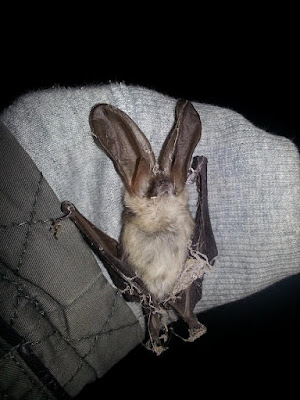Back in May 2014 I didn't know much about bats, and as a city kid who seldom noticed them fluttering about they weren't really something I had thought about much before.
This all changed when I set my sights on a career in Ecology, as UK bat species and their roosts are protected by law. After a little bit of research and a few days of volunteering with a local consultancy it became clear to me that bats were a key part of the industry, and before I knew it I was off to shadow an ecologist on my first consultancy bat survey.
I was really excited to hear a bat echo locate for the first time on a heterodyne, I'd heard their high pitched squeaks occasionally while out and about at dusk but I'd never had the chance to listen to them properly before.
It was a rural site down in the wilds of the Vale of Glamorgan with some old derelict barns. The first bat I heard was a Daubenton's bat (Myotis daubentonii) which sounded like an explosion of marbles on the heterodyne, I also soon heard Common Pipistrelle (Pipistrellus pipistrellus) and Soprano Pipistrelle (Pipistrellus pygmaeus) which sounded more like a series of smacks with some background bubbling.
By the end of the survey I knew I was a total bat convert, but I had no idea how I was ever going to learn and remember all the different species, especially with all those peculiar sounds they made. But equipped with the right heterodyne and some new books, I persevered and started to attend and undertake bat surveys regularly and began to tell them apart in no time.
My bat book recommendations:
- British Bat Calls: A Guide to Species Identification. By Jon Russ - A great book for beginners, packed full of information about all the UK species and includes call sonograms.
- Bat Surveys: Good Practice Guidelines. From the Bat Conservation Trust - Great if you're looking to swat up on survey technique and legislation etc. (can be downloaded for free from their website)
I also joined the Bat Conservation Trust and found that they had some bat sound samples that turned out to be really useful for field comparison.
Separating the species was also made easier by the type of heterodyne I used, the Elekon Bat Scanner. Some bat enthusiasts call this the 'lazy persons heterodyne' because it is automatic and therefore does not need to be tuned to the right frequency. Personally, I think it's a great little machine as you do not need to scroll through different frequencies whilst using it which ensures that you won't miss any bat species, as they can range from 15 KHz up to 114 KHz.
It's also great for when you're still learning, as knowing the exact frequency can help to separate similar sounding species like the Common and Soprano Pipistrelles. However, they are a little bit on the pricey side, so a Magenta dial-turn heterodyne might be a better investment if you just fancy being a casual bat listener.
There is also a great app from Elekon for your smartphones. It's called Elekon Bat Library, it's completely free and has a library of calls for comparison in the field.
Hopefully I'll get a chance to upload some sound bites later in the year, as I will most likely be bat surveying again soon during the survey season which is May-September.
Dead Brown Long Eared bat found hanging on a barn wall.
Here's a quick list of bat survey/watching essentials you may need....
- Something that tells you the time - Bats come out at dusk, just before and after sunset, keep an eye on the time so you know when to expect them.
- Heterodyne - Automatic or not.
- Camp chair - Might as well make yourself comfortable, but feel free to get up and walk around.
- Warm clothes - It can get chilly in the dark when you're not moving around much and no one likes being cold.
- Snacks/flask of tea (optional) - If you're planning on being there a while...
- Torch - We can take being able to see for granted when the sun is out, even just an app on your phone will be extremely useful if you find yourself in a dark field.
Look forward to some future posts about our UK species soon and I wish you happy batting in the future!




No comments:
Post a Comment